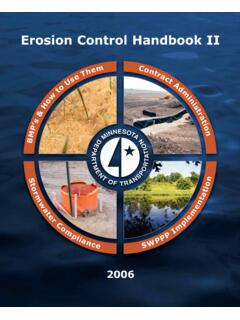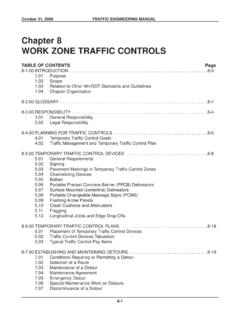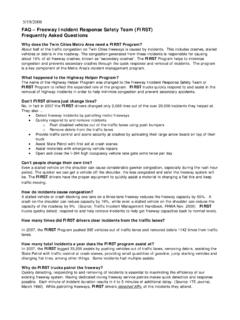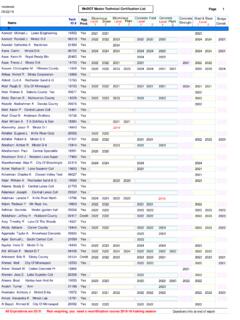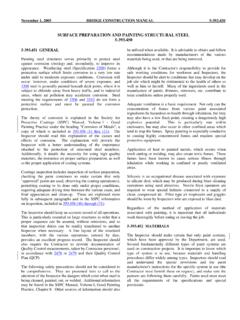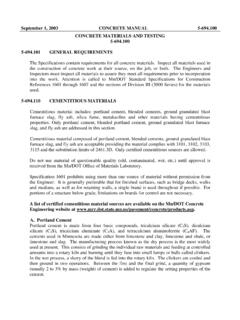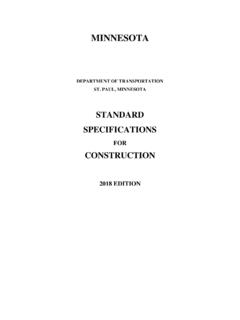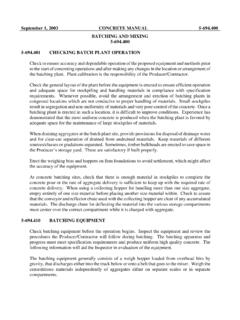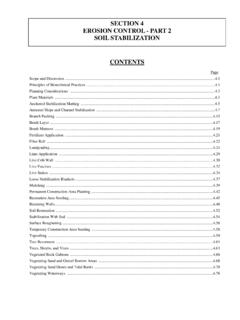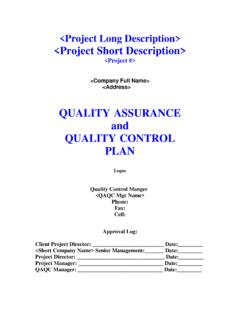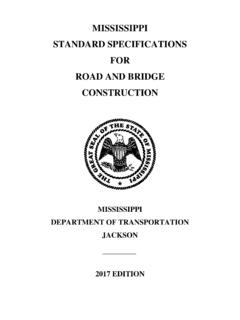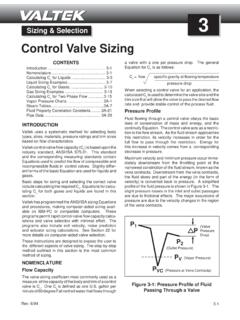Transcription of Seeding Manual 2014 Edition - Minnesota Department of ...
1 1 Seeding Manual 2014 Edition Office of Environmental Stewardship erosion control Engineering Unit 2 Mn/DOT Seeding Manual The Seeding Manual entails methods used to establish and maintain both general and native seed mixtures for roadside plantings throughout the state of Minnesota . The Manual provides a basic guide to the seed mixtures that Mn/DOT typically specifies and the methods for placement. For detailed Seeding and mulch recommendations, refer to the individual Mn/DOT district Seeding recommendations. Seed Mixtures The seed mixtures described in Mn/DOT s Standard Specifications for Construction 2014 Edition will be specified and used on construction projects Seed Mixtures from the 1995, 2000, and 2005 editions of the Standard Specifications for Construction should no longer be specified.
2 3 Table of Contents Subject Page # Basic Seed Mixture Design Information 5 General Seed Mixture Overview 5 Season of Planting 6 Dormant Seeding 6 Snow Seeding 6 Seed Mix Conversion Table 7 Seed Mixes 8 Establishing Non-Native Seed Mixtures 35 General Recommendations 35 Temporary erosion control 35 Fertilizer 35 Seeding Methods 36 Method 1. Drop Seeding Onto Tilled Sites 36 Method 2. Hydroseeding 36 Method 3. Broadcast Seeding 36 Method 4. Interseeding Into Existing Vegetation or Mulch 37 Establishing Native Grasses and Forbs 37 General Recommendations 37 Native Grass and Forb Mixtures 38 Cover/nurse Crops 38 Temporary erosion control 38 Fertilizer 39 Seeding Into Agricultural Fields 39 Inoculants 39 Seed Treatments 39 Seeding Methods 40 Method 1.
3 Drop Seeding Onto Tilled Sites 40 Method 2. Drill Seeding Into Temporary Cover Crops 40 Method 3. Drill Seeding Into Existing Vegetation 41 Method 4. Broadcast Seeding 42 Method 5. Hydroseeding 42 Maintenance Requirements 43 General Seed Mixtures (25-121, 25-141 and 25-142) 43 Turfgrass Mixtures (25-131 and 25-151 ) 43 Native Grass and Forb Mixtures (mixtures beginning with the number 3) 44 4 5 Basic Seed Mixture Design Information The following recommendations are intended to provide general guidance for the areas in which mixtures listed should be used. Note that within each mixture tabulation, at the end of this Manual , there is a brief description of the mix and what it was developed for.
4 The Seeding rates listed are for roadside establishment and initial erosion control . The rates are somewhat higher than rates used for Seeding parkland fields and other non-roadside areas. General Seed Mixture Overview Table 1 Recommended Seed Mixtures Purpose Mixture Seeding Rate (lbs/acre) Maintenance Temporary Fall Cover 21-112 100 N/A Spring/Summer Cover 21-111 100 N/A Soil-building Cover 21-113 110 N/A 1 to 2 years of Cover 22-111 N/A 2 to 5 years of Cover 22-112 40 N/A General Sandy Roadside 25-121 61 Mow up to 3 times per year General Roadside 25-141 59 Mow up to 3 times per year Commercial Turf 25-131 220 Mow a minimum of once per 4 weeks Residential Turf 25-151 120 Mow a minimum of once per 2 weeks Agricultural Area Roadside 25-142 45 Mow up to 3 times per year Native Ponds & Wet Areas in Central.
5 Southern and Western MN 33-261 35 To reduce weed establishment, mow 2 to 3 times (30 days apart) during 1st year with the mower deck about 6 -8 off the ground. Mow one time during the 2nd year before weeds set their seeds. Burn or mow once every 3 to 5 years following the initial 2 years of maintenance to remove dead plant material and stimulate new seed. Ponds & Wet Areas in Northeast MN 33-361 35 Sandy/dry Areas- Short Grasses 35-221 General Roadside 35-241 Wet Prairie 34-262 Riparian areas in Central, Southern, and Western MN 34-261 Riparian areas in Northeast MN 34-361 Partly shaded roadsides in Southern and Western MN 36-211 Partly shaded roadsides in Northeast MN 36-311 Partly shaded roadsides in Northwest MN 36-411 Partly shaded roadsides in Central MN 36-711 6 Season of Planting The season of planting for seed mixtures runs from spring to early summer and from fall until the ground freezes.
6 Table 2 lists the general dates when Seeding of various Mn/DOT mixes should occur. Seasons can be extended based on the current weather patterns, such as frequent low intensity rainfalls with cooler than average temperatures. Table 2 SEASON OF PLANTING Seed Mixture Number Spring Fall 21-112 --- Aug. 1 Oct. 1 21-111 & 21-113 May 1 Aug. 1 --- 22-111, 22-112 April 1 - July 20. July 20 Oct. 20 25-121, 25-141, 25-131, 25-151 April 1 - June 1 July 20 - Sept. 20 25-142 April 1 Sept. 1 --- Mixes beginning with number 3 April 15 July 20 Sept. 20 Oct.
7 20 Note: For the portion of Minnesota north of, and including TH 2, the Season of Planting for Mixtures 22-111 through 25-151 shall be April 15 through September 20. Dormant Seeding When dormant Seeding , it is important to note different species are dormant at different times of the year. Dormant Seeding for warm-season grasses occurs in early fall as they require 65 F and above sustained soil temperatures and moisture to germinate. Cool-season grasses will germinate at colder temperatures, a soil temperature at a depth of 1 at or below 40 F. Cool-season grasses generally germinate in a shorter period of time.
8 Many forbs will not germinate at all the first year when seeded in the spring as they require a freeze/thaw period (winter) to germinate. Thus, forbs may not appear until the following spring. Dormant Seeding is somewhat risky due to factors such as weather, snow cover, predation, and soil erosion . However, plantings do appear to contain more diversity of cool-season grasses and forbs when installed in the fall. Snow Seeding Seeding on top of the snow with a prepared seedbed below the snow is considered snow Seeding and usually performed due to contract constraints.
9 When this is done the seed will melt through the snow and germinate when it reached the correct temperature in the spring. Mulch can also be placed over the snow on top of the seeded site. Snow Seeding can be done during the thawing days in February and March. 7 Seed Mix Conversion Table Table 3: Seed Mixes Click the mix number to see details for each mix CATEGORY NUMBER PLS Rate NAME REPLACES Cover Crop 21-111 100 Oats Cover Crop MNDOT 110, BWSR UT1 21-112 100 Winter Wheat Cover Crop MNDOT 100 21-113 110 Soil Building Cover Crop MNDOT 130 Mid-Term Stabilization 22-111 Two-year Stabilization MNDOT 150 22-112 Five-year Stabilization MNDOT 190 Non-Native Grassland 25-121 Sandy General Roadside MNDOT 240 25-131 220 Low Maintenance Turf MNDOT 260 25-141 59 Mesic General Roadside MNDOT 250 25-142 45 Agricultural Roadside MNDOT 280 25-151 120 High Maintenance Turf MNDOT 270 Mid-term Stabilization Native 32-241 38 Native Construction BWSR U12.
10 BWSR U11 Stormwater Facilities 33-261 35 Stormwater South and West MNDOT 310 & 328 33-262 44 Dry Swale / Pond BW SR W4 33-361 35 Stormwater Northeast BW SR W7, MNDOT 310 & 328 Wetland 34-171 Wetland Rehabilitation BW SR WT3 34-181 5 Emergent Wetland BW SR W1 34-261 Riparian South & West BWSR R1 34-262 Wet Prairie BWSR W3, MNDOT 325 34-271 12 Wet Meadow South & West BW SR W2 34-361 Riparian Northeast BWSR R1 34-371 Wet Meadow Northeast BW SR W2N Native Grassland 35-221 Dry Prairie General MNDOT 330 35-241 Mesic Prairie General MNDOT 350 35-421 11 Dry Prairie Northwest BWSR U2 35-441 11 Mesic Prairie Northwest BWSR U1 35-521 Dry Prairie Southwest BWSR U4 35-541 12 Mesic Prairie Southwest BWSR U3 35-621 11 Dry Prairie Southeast BWSR U6 35-641 12 Mesic Prairie Southeast BWSR U5 Woodland 36-211 Woodland Edge South & West BWSR U7 36-311 Woodland Edge
